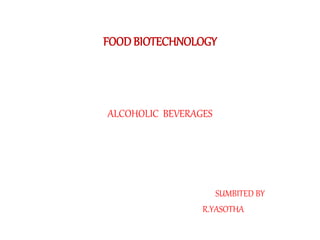
Alcoholic Beverages
- 1. FOOD BIOTECHNOLOGY ALCOHOLIC BEVERAGES SUMBITED BY R.YASOTHA
- 2. INTRODUTION All alcoholic beverages involve the action of fungi. Most involve the genus Saccharomyces. These yeasts covert six carbon sugars such as glucose to ethanol and carbon dioxide and live under anaerobic conditions. Yeasts can tolerate fairly high concentrations of alcohol (up to about 14-18%) in the medium. Alcoholic beverages are known from virtually all cultures. These beverages are major social problems, but also sources of nutrition. Many plants have been used to prepare alcoholic beverages. Mead is made from fermented honey.
- 3. Plants often store nutrition as starch. Yeasts cannot use starch. The starch is broken down by enzymes in the plant into sugars. The sugars are then converted by the yeasts into ethanol and carbon dioxide. Alcohol is a lipid and moves freely across membranes in the stomach. Alcohol is broken down in humans, but also affects the neurons and is a non-selective central nervous system depressant.
- 4. YEAST In browing, alcoholic fermentation comprises the conversion of sugar into carbondioxide and ethyl alcohol. This process is carried out by yeast enzymes. In browning we use the sugar fungi form of yeast. These cells gain energy from breaking down the sugar. The product, CO2 bubbles through the liquid and dissipates into air. Alcohol remains in the yeast cells die, when the level of alcohol exceeds beyond tolerance. Brewers yeast tolerates about 5% alcoholic beyond this level the yeast can not continue fermentation. The overall process of fermentation aims to convert glucose sugar (C6H2O6) into alcohol(CH3CH2OH)and carbondioxide.
- 5. The reaction with in yeast make this happen:
- 6. BREWER’S YEAST Brewer’s yeast is dried, pulverized cells of saccharomyces cervisia, a type of yeast that reproduce by budding. They are hundreds of varieties and straing of this yeast in the past, there were two types of beer yeast; ale yeast : [ the “top fermenting type, saccharomyces cerviside ]and large yeast: [the “bottom – fermenting “type, saccharomyces uvarum,tormerly known as saccharomyces carlsbergensis].
- 7. ALE YEAST: Ale yeast strains are best used at temperatures between 10 and 25*c though some strains will not actively ferment below 12*c ale yeast is generally regarded as top – fermenting yeast since it rises to the surface during fermentation, creating a very thick, rich yeast head. That why the lerm “top fermenting” is assosiated with ale yeast. Ale yeast produce beer high in esters.
- 8. LARGE YEAST; Large yeast strains are best used at temperature between 7and 15*C large yeast – grow less rapidly than ale yeasts, and with less surface form they tend to settle to the bottom of the fermenter at the and of fermentation. This is why they are often refferred as “bottom” fermenting yeasts. The final flour of beer will however, depend greatly on the strain of yeast and the temperatures at which it is fermented. .
- 9. YEAST LIFE CYCLE; Yeast is activated from dormancy as soon as it is added [pitched] to the wort. yeast growth follows four phases: The lag phase Growth phase Fermentation phase Sedimentation phase
- 10. LAG PHASE: Reproduction is the priority in pitching, and the yeast will not show any other activity untill food reserves are built up this stage is marked by a drop in PH due to untilyzation of phosphate and reduction in oxygen. Glycogen,an intracelluler carbohydrate reserve. Is a prime energy sources for cell activity since wort sugars are not assimilated early in the lag phase.low geycogen levels produce abnormal levels of vicinal dixetones [ especialy diacetyl]and may result in longer fermentation.
- 11. Growth phase The growth phase aften refered to as the respiration phase,follows the log phase once sufficient reserves are built up within the yeast. In this phase the yeast cells use oxygen in worth to oxidize a variety of acid compounds resulting in a significant drop of PH. In this connection, some yeast strains will result in a much greater fall in PH than others with in the same fermenting wort.
- 12. FERMENTATION PHASE: The fermentation phase quickly follows the growth phase when the oxygen supply was been depleted. Fermentation is an anaerobic process. In fact any oxygen remaining in the wort is stripped out of the solution by carbondioxide bubbles produced by yeast. This phase is characterized by the reduction of wort gravity and the production of carbondioxide. ethanol and beer flavours. Most beer yeast will remain in suspension for 3or7days, after which flocculation and sedimentation will commence.
- 13. SEDIMENTATION PHASE: The sedimentation phase is when the yeast flocclates and settles to the bottom of the fermenter. The yeast produces a substance called glycogen, wich will preserve its. Life as it prepares it self for dormancy. Glycogen is necessary for cell maintance during dormancy and is an energy source during the lag phase.
- 14. Products of Alcoholic Fermentation
- 15. WINE FLOW CHARTS Ripe grapes Washing, removal of stem and crushing Filling jar up to ¾ Addition of sugar Adjustment of pH [0.6-0.8] Addition of preservative [1.5g/10kg of fruit] Addition of wine yeast [S.ellopodevs] Fermentation [For 2 day] Filtration
- 16. Fermentation[For 10 days] Packing [siphoning of clear liquid] Fining and filtration [bentonies] Aging 6-8 [months] Bottling Crocon corking Pasteurization[85*c for 20min] Cooling Storage
- 18. BEER FLOW CHART Barley grains Washing Soaking Malting [involves soaking, steeping, germination, drying and crushing.] Mashing [mixing of ground malt with water and heated at 70*C Worting [inactivation of enzyme] and boiling with hops S.cervisiae S.carlbergenos fermentation Maturing Packaging
- 19. Barley fields in California and Germany
- 20. BRANDY FLOW CHART Cashew apple fruits Plucking and removing nuts Transportation Washing and weighing Fruit-mill Juice extraction Sulphitation Inoculation Fermentation
- 21. Distillation Adjusting the strength to 60% Aging in wooden barrels Dilution to 43% alcohol Bottling Labelling
- 22. VODKA FLOW CHART
- 24. TANK YOU